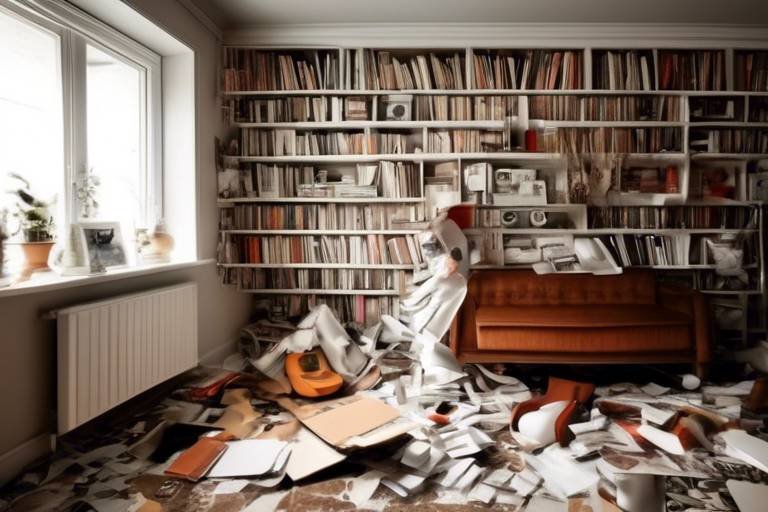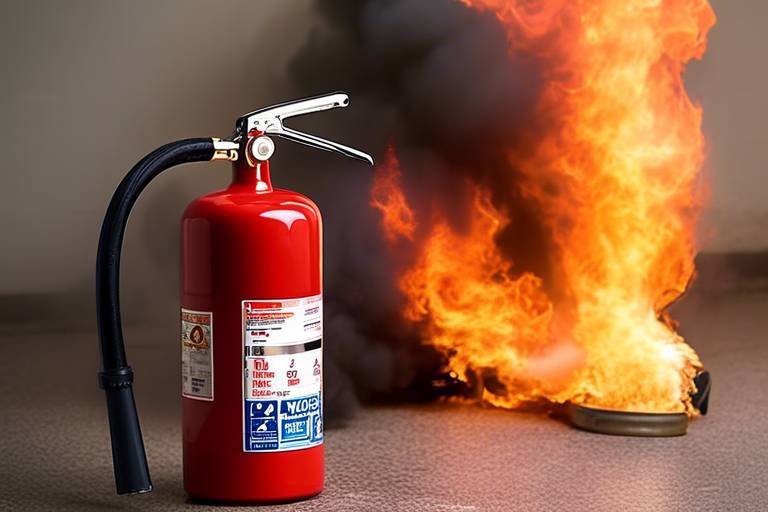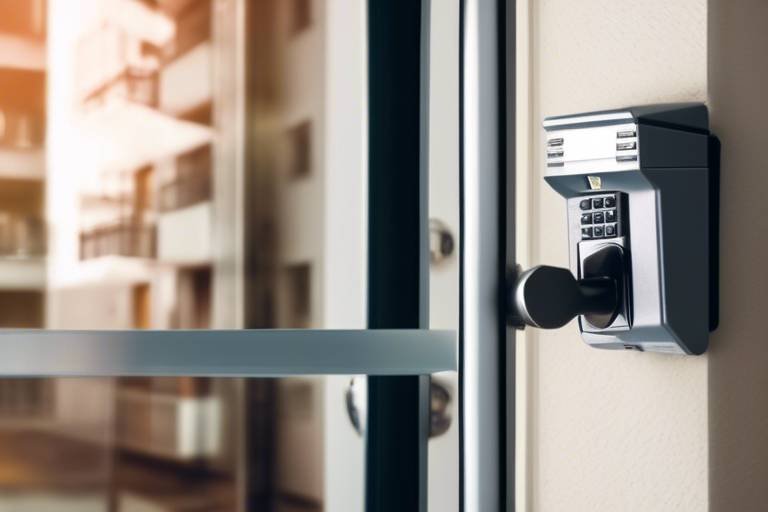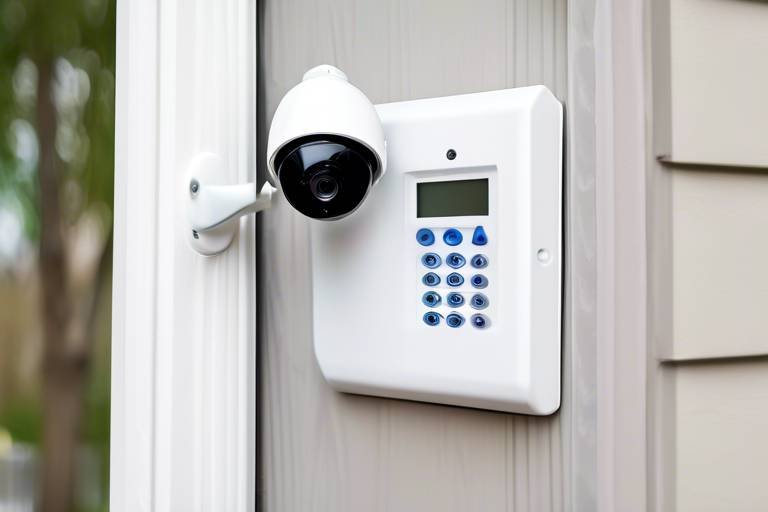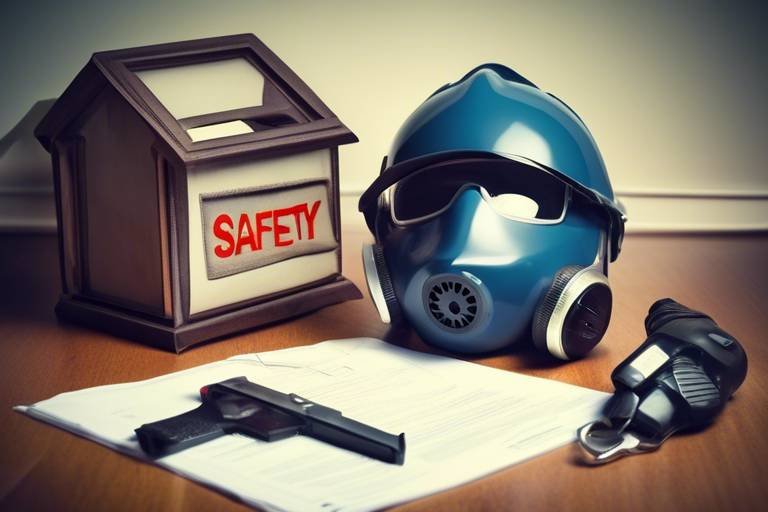Securing Balconies and Terraces in Apartment Buildings
When it comes to apartment living, balconies and terraces are often seen as coveted spaces—extensions of our homes that offer a breath of fresh air and a slice of outdoor life. However, with great views come great responsibilities. The safety and security of these areas are paramount, not just for the residents who enjoy them but also for the overall integrity of the building. Ensuring that these spaces are secure can seem daunting, but with a few strategic measures, we can transform them into safe havens. In this article, we will explore various strategies and best practices for enhancing the safety and security of balconies and terraces in apartment buildings, ensuring residents can enjoy these spaces without concern.
Before we can enhance safety, it's essential to recognize the potential hazards associated with balconies. The risks of falls and unauthorized access are significant, especially in multi-story buildings where the consequences can be severe. Picture this: a child playing near the edge of a balcony, a moment of distraction, and suddenly, the unthinkable happens. By identifying these hazards, we can implement effective safety measures that protect not just residents but also their guests. Moreover, it’s crucial to educate residents about the risks, encouraging them to be vigilant and responsible while using these shared spaces.
Familiarizing yourself with local safety regulations and standards is crucial for ensuring that balconies and terraces comply with legal requirements. This knowledge not only minimizes risks but also enhances overall safety. Regulations vary by location, but they typically cover aspects like load-bearing requirements, guardrail specifications, and inspection protocols. Ignorance of these regulations can lead to severe consequences, including fines or, worse, accidents. It’s akin to driving without knowing the rules of the road—dangerous and irresponsible.
Let’s delve into the building codes related to balcony construction and safety features. These codes are designed to provide a framework that ensures the integrity and safety of these structures. For instance, they often dictate the materials used, the design of guardrails, and even the types of plants that can be safely placed on balconies. Adhering to these codes not only protects residents but also enhances the property’s value. It’s a win-win situation!
Understanding load-bearing requirements is vital for ensuring that balconies can support the weight of occupants and furniture. Imagine hosting a small gathering on your balcony, with friends lounging and enjoying drinks. If the balcony isn’t built to handle that weight, you could be setting yourself up for disaster. Building codes typically specify the maximum load a balcony can support, and it’s essential to adhere to these guidelines to prevent structural failures and accidents. Regular assessments by professionals can help ensure compliance and safety.
Guardrails are a critical safety feature for preventing falls. This section outlines the height, strength, and design standards necessary for effective balcony guardrails. For example, guardrails must typically be at least 42 inches high and constructed to withstand significant force. Think of them as the safety net that keeps you secure while enjoying the view. A well-designed guardrail not only protects but can also enhance the aesthetic of the balcony, adding to its charm.
Regular inspection and maintenance of balconies and terraces are essential for identifying wear and tear. Just like a car needs regular oil changes to function efficiently, balconies require periodic checks to ensure safety features remain effective and compliant with regulations. This proactive approach can prevent minor issues from escalating into serious problems. It’s important to encourage residents to report any signs of damage or deterioration immediately, fostering a community of safety awareness.
Implementing security measures such as surveillance cameras, access control systems, and adequate lighting can significantly enhance the safety of balconies and terraces in apartment buildings. These measures act as deterrents to unauthorized access and provide peace of mind to residents. Imagine coming home after a long day and feeling secure knowing that your balcony is monitored and protected. It’s all about creating an environment where residents can relax without worry.
The installation of surveillance systems can deter unauthorized access and provide residents with peace of mind. These systems can be integrated with smart technology, allowing residents to monitor their balconies remotely. It’s like having a digital guardian watching over your outdoor space. The presence of cameras not only helps in preventing crime but also assists in resolving disputes or incidents that may occur.
Access control solutions, such as keycard entry or coded locks, help restrict access to balconies and terraces, ensuring that only authorized individuals can enter these areas. This technology can be particularly useful in buildings with multiple tenants, preventing unauthorized access and enhancing overall security. Imagine the peace of mind that comes from knowing that only you and your guests can access your balcony. It’s about creating a safe, private retreat in the midst of urban living.
Q: What are the main hazards associated with balconies?
A: The primary hazards include falls, unauthorized access, and structural failures due to improper load-bearing capacity.
Q: How can I ensure my balcony meets safety regulations?
A: Familiarize yourself with local building codes, regularly inspect your balcony, and consult professionals for compliance checks.
Q: What security measures can I implement for my balcony?
A: Consider installing surveillance cameras, access control systems, and adequate lighting to enhance security.

Understanding Balcony Hazards
This article explores various strategies and best practices for enhancing the safety and security of balconies and terraces in apartment buildings, ensuring residents can enjoy these spaces without concern.
When it comes to balconies and terraces, it's crucial to recognize the potential hazards that can compromise safety. Balconies, while providing a fantastic space for relaxation and enjoyment, can also pose serious risks if not properly managed. One of the most significant dangers is the risk of falls. Imagine a beautiful sunny day where you step out to enjoy your morning coffee, but a loose railing or an unstable surface could turn that peaceful moment into a nightmare. Falls can occur due to various reasons, including:
- Inadequate guardrails or barriers
- Slippery surfaces from rain or spills
- Overcrowding or excessive weight
Another critical hazard is unauthorized access. Balconies can become easy entry points for intruders if not secured properly. This can lead to theft, vandalism, or even personal harm to residents. Ensuring that balconies are not only safe but also secure is essential for peace of mind. Think about it: would you want to relax in your outdoor space, knowing that anyone could stroll in uninvited?
In addition to these concerns, we must also consider environmental factors. For instance, high winds can pose a threat, especially if there are loose items like furniture or plants that could be blown off the balcony. It’s important to assess the layout and design of balconies to minimize these risks. Regular maintenance checks can help identify any wear and tear that might lead to hazardous situations, such as rusted railings or cracked flooring.
To summarize, understanding the hazards associated with balconies and terraces is the first step in creating a safe environment for all residents. By being proactive and addressing these risks, we can ensure that balconies remain a delightful feature of apartment living rather than a source of anxiety or danger.
Familiarizing yourself with local safety regulations and standards is crucial for ensuring that balconies and terraces comply with legal requirements, thereby minimizing risks and enhancing overall safety.
An overview of building codes related to balcony construction and safety features, which must be adhered to for compliance and resident safety in apartment buildings.
Understanding load-bearing requirements is vital for ensuring that balconies can support the weight of occupants and furniture, preventing structural failures and accidents.
Guardrail specifications are critical for preventing falls; this section outlines the height, strength, and design standards necessary for effective balcony guardrails.
Regular inspection and maintenance of balconies and terraces are essential for identifying wear and tear, ensuring that safety features remain effective and compliant with regulations.
Implementing security measures such as surveillance cameras, access control systems, and lighting can significantly enhance the safety of balconies and terraces in apartment buildings.
The installation of surveillance systems can deter unauthorized access and provide residents with peace of mind, creating a safer environment on balconies and terraces.
Access control solutions, such as keycard entry or coded locks, help restrict access to balconies and terraces, ensuring that only authorized individuals can enter these areas.
Q: What are the common hazards associated with balconies?
A: Common hazards include falls due to inadequate guardrails, slippery surfaces, overcrowding, and unauthorized access.
Q: How can I ensure my balcony is safe?
A: Regular maintenance, adhering to building codes, and installing safety features like guardrails and surveillance systems are key to balcony safety.
Q: Are there regulations for balcony safety?
A: Yes, local building codes outline specific safety standards for balconies, including load-bearing requirements and guardrail specifications.

Safety Regulations and Standards
When it comes to ensuring the safety of balconies and terraces in apartment buildings, understanding safety regulations and standards is not just important—it’s essential. These regulations are designed to protect residents and visitors alike, and they establish a framework for what is deemed safe and acceptable in balcony design and construction. Familiarizing yourself with these guidelines can help prevent accidents and ensure that your living environment is secure.
In many regions, safety regulations are enforced at both the local and national levels. These regulations often include specific requirements regarding the construction materials, design features, and maintenance of balconies. For instance, the International Building Code (IBC) provides a comprehensive set of guidelines that many municipalities adopt. It’s crucial to check with your local building authority to understand which codes apply to your area.
One of the key aspects of these regulations is the load-bearing requirements. Balconies must be able to support not only the weight of the occupants but also any additional loads from furniture, plants, and other items. This means that the materials used in construction must be robust and durable. For example, a typical residential balcony should be designed to support a minimum live load of 40 pounds per square foot. Failure to comply with these requirements can lead to catastrophic failures, resulting in injuries or fatalities.
Additionally, guardrails are a critical component of balcony safety. The guardrail specifications outlined in safety regulations dictate the height, strength, and design of these barriers. For instance, guardrails should typically be at least 42 inches high and made from materials that can withstand significant force. This ensures they can effectively prevent falls, which are one of the leading causes of accidents on balconies. It's not just about having a guardrail; it must meet specific standards to be effective.
To give you a clearer picture, here’s a quick overview of some common safety regulations related to balconies:
| Regulation | Description |
|---|---|
| Load-Bearing Capacity | Balconies must support a minimum of 40 pounds per square foot. |
| Guardrail Height | Guardrails must be at least 42 inches high. |
| Guardrail Strength | Guardrails must withstand a force of at least 200 pounds. |
Regular inspections and maintenance are also mandated by safety regulations. They ensure that balconies remain in compliance with the latest standards and that any wear and tear is addressed promptly. Neglecting these aspects can lead to safety hazards that could easily be avoided with a little diligence.
In summary, adhering to safety regulations and standards is not merely a suggestion; it is a necessity for anyone involved in the management or design of apartment buildings. By understanding and implementing these regulations, you can create a secure environment for all residents. So, whether you’re a property manager, a homeowner, or an architect, make it a priority to stay informed and compliant. After all, a safe balcony is a happy balcony!

Building Codes Overview
When it comes to ensuring the safety and security of balconies and terraces in apartment buildings, understanding building codes is paramount. These codes are not just a bunch of rules; they are the backbone of structural integrity and resident safety. Think of them as the safety net that catches you when you take a leap—without them, you're left hanging in the air, unsure of what might happen next.
Building codes vary from one region to another, but they generally cover several critical aspects that are essential for the construction and maintenance of balconies. This includes regulations on materials, structural support, and safety features. For instance, the codes dictate the maximum height of guardrails, the types of materials that can be used, and even the load-bearing capacities of balconies. Each of these factors plays a significant role in preventing accidents and ensuring that residents can enjoy their outdoor spaces without worry.
To give you a clearer picture, let’s break down some of the key elements covered by building codes:
- Materials: The codes specify which materials are acceptable for use in balcony construction. This ensures that the materials can withstand environmental factors like moisture, temperature changes, and wear and tear.
- Structural Integrity: Building codes require that balconies be designed to support a specific weight, which includes not just the occupants but also furniture, plants, and any other items that might be placed on them.
- Safety Features: Regulations often include requirements for guardrails, ensuring they are tall enough and strong enough to prevent falls.
Compliance with these codes is not optional. It’s a legal requirement that protects not just the residents but also the property owners and builders. Failing to adhere to building codes can lead to severe consequences, including fines, lawsuits, and, in the worst-case scenario, tragic accidents. Therefore, it’s crucial for property managers and owners to stay informed about local regulations and implement them effectively.
In summary, understanding building codes is like having a roadmap for safety. It guides you through the necessary steps to ensure that balconies and terraces are not only beautiful spaces for relaxation but also secure areas where residents can feel safe. By prioritizing compliance with these codes, you are investing in the well-being of everyone who calls your apartment building home.
Q1: What are the consequences of not following building codes?
A1: Not adhering to building codes can result in fines, legal action, and increased liability in the event of an accident. It can also lead to structural failures, putting residents at risk.
Q2: How often should balconies be inspected?
A2: It’s recommended that balconies be inspected at least once a year, or more frequently if they show signs of wear or damage. Regular inspections can help catch issues before they become serious problems.
Q3: Can I make changes to my balcony without consulting building codes?
A3: It’s essential to consult local building codes before making any changes to your balcony. Unauthorized modifications can violate safety regulations, leading to potential hazards.

Load-Bearing Requirements
When it comes to ensuring the safety of balconies and terraces in apartment buildings, understanding is absolutely critical. Imagine a balcony as a sturdy bridge, designed to hold not just the weight of the structure itself but also the people and furniture that may occupy it. If this weight exceeds the balcony's capacity, it can lead to disastrous consequences, including structural failure and potential injuries to residents and visitors alike.
Typically, the load-bearing capacity of a balcony is determined by several factors, including the materials used in its construction, the design of the supporting structures, and the local building codes that govern these aspects. For instance, a balcony made of reinforced concrete will generally have a higher load-bearing capacity than one constructed from wood or composite materials. Therefore, it's essential to consult with a qualified engineer or architect during the design phase to ensure that the balcony can safely support the intended loads.
Generally, balconies are designed to withstand both live loads and dead loads. Live loads refer to the weight of occupants and movable objects such as furniture, while dead loads pertain to the weight of the structure itself. For residential balconies, building codes often specify a minimum live load capacity of around 40 pounds per square foot (psf). However, this can vary based on local regulations and specific design requirements.
| Load Type | Description | Typical Requirement |
|---|---|---|
| Dead Load | Weight of the balcony structure itself | Determined by material specifications |
| Live Load | Weight of occupants and movable objects | Minimum 40 psf (varies by code) |
Moreover, it's not just about the weight; the distribution of that weight is equally important. A poorly distributed load can lead to stress concentrations in certain areas, increasing the risk of failure. Therefore, it’s advisable to avoid placing heavy items in the corners of a balcony and to distribute furniture evenly across the surface.
Regular inspections are also vital to ensure that the balcony remains safe and compliant with load-bearing requirements. Over time, factors such as weathering, rust, and material degradation can affect the structural integrity of the balcony. By conducting periodic assessments, property managers can identify potential issues before they escalate into serious problems.
In summary, load-bearing requirements are not just a technical detail; they are a fundamental aspect of balcony safety that should never be overlooked. By understanding these requirements and adhering to them, we can create safe and enjoyable outdoor spaces for residents to relax and unwind.
- What is the minimum load-bearing capacity for balconies?
The minimum live load capacity for residential balconies is typically around 40 pounds per square foot, but this can vary by local building codes. - How can I ensure my balcony is safe?
Regular inspections and adherence to building codes are essential. Consult with a qualified engineer to assess load-bearing requirements. - What materials are best for balcony construction?
Reinforced concrete typically offers a higher load-bearing capacity compared to wood or composite materials.

Guardrail Specifications
When it comes to ensuring the safety of balconies and terraces in apartment buildings, guardrails play a pivotal role. These structures are not just decorative; they are essential safety features designed to prevent falls and accidents. The specifications for guardrails are dictated by various safety standards and building codes, which must be adhered to for optimal protection. First and foremost, guardrails should be a minimum height of 42 inches from the walking surface to effectively prevent individuals from toppling over. This height is critical, especially in multi-story buildings where the risks of falls are significantly higher.
Moreover, the strength of guardrails is equally important. They should be constructed to withstand a force of at least 200 pounds applied in any direction. This requirement ensures that the guardrail can endure not only the weight of individuals leaning against it but also any unexpected forces that may occur, such as strong winds or accidental impacts. The materials used for guardrails must also be considered; they should be durable and resistant to weather conditions to prevent deterioration over time. Common materials include steel, aluminum, and composite materials, each offering different benefits in terms of strength, weight, and maintenance.
In addition to height and strength, the design of guardrails should also be taken into account. They should have no openings that exceed 4 inches to prevent small children from slipping through. This is particularly crucial in family-friendly apartment complexes where children may be playing nearby. Furthermore, the design should not have any sharp edges or protrusions that could cause injury, ensuring a smooth and safe surface for residents and visitors alike.
To summarize, here are some key specifications for guardrails:
| Specification | Requirement |
|---|---|
| Height | Minimum 42 inches |
| Load Capacity | Must withstand 200 pounds |
| Opening Size | No openings greater than 4 inches |
| Materials | Durable options like steel, aluminum, or composite |
By adhering to these specifications, apartment buildings can significantly enhance the safety of their balconies and terraces, providing peace of mind to residents and their families. It’s not just about compliance; it’s about creating a secure and enjoyable living environment. After all, a well-designed guardrail can be the difference between a relaxing evening on the balcony and a potential accident. So, when planning or renovating these spaces, make sure to prioritize guardrail specifications as part of your safety strategy.
- What is the minimum height for guardrails on balconies? The minimum height is typically 42 inches.
- How much weight can guardrails support? Guardrails should be able to withstand a force of at least 200 pounds.
- Are there specific materials recommended for guardrails? Yes, durable materials like steel, aluminum, and composite are commonly used.
- What is the maximum opening size allowed in guardrails? Openings should not exceed 4 inches to prevent falls.

Inspection and Maintenance
Regular inspection and maintenance of balconies and terraces are not just good practices; they are essential for ensuring the safety and longevity of these outdoor spaces. Think of it as giving your balcony a health check-up—just like we visit the doctor to catch potential issues early, our balconies need the same attention. Over time, wear and tear can compromise the structural integrity of balconies, leading to dangerous situations for residents and visitors alike.
One of the first steps in an effective inspection process is to identify the common signs of damage. This includes looking for cracks in the flooring, rust on metal components, or loose railings. It’s crucial to conduct these inspections at least twice a year, ideally in the spring and fall, to catch any issues before they worsen. During these inspections, consider the following:
- Surface Integrity: Check for cracks, chips, or uneven surfaces that could pose tripping hazards.
- Guardrail Stability: Ensure that guardrails are securely fastened and meet the height requirements.
- Drainage Systems: Inspect drainage systems to prevent water accumulation, which can lead to structural damage.
Moreover, maintaining these areas doesn’t end with inspections. It’s important to have a maintenance plan in place that addresses any identified issues promptly. This plan should include a schedule for repairs, cleaning, and updates to safety features. For instance, if you notice rust on metal railings, it’s essential to treat and repaint them to prevent further deterioration. Similarly, if the flooring shows signs of wear, consider refinishing or replacing it to maintain a safe environment.
In addition to physical inspections, it’s also wise to engage a professional inspector at least once every few years. Professionals can provide a more thorough assessment and identify underlying issues that might not be immediately visible. They can also ensure compliance with local building codes and safety standards, giving you peace of mind that your balcony is safe for use.
Ultimately, the goal of regular inspection and maintenance is to create a safe and enjoyable outdoor space for residents. By investing time and resources into these efforts, you're not only safeguarding the physical structure of the balcony but also enhancing the overall living experience in the apartment building. Remember, a well-maintained balcony is a happy balcony!
- How often should I inspect my balcony? It's recommended to inspect your balcony at least twice a year, especially after severe weather conditions.
- What should I look for during an inspection? Look for cracks, rust, loose railings, and ensure that drainage systems are functioning properly.
- Do I need a professional for inspections? While you can conduct regular inspections yourself, hiring a professional every few years can help identify hidden issues.
- What are the common repairs needed for balconies? Common repairs may include fixing cracks, repainting rusted areas, and replacing worn-out flooring.

Enhancing Security Measures
When it comes to enjoying our balconies and terraces, the last thing we want is to feel uneasy about safety. After all, these outdoor spaces are meant for relaxation, socializing, and soaking up the sun. To achieve this peaceful experience, implementing robust security measures is absolutely essential. Think of your balcony as a cozy retreat; just like you wouldn’t leave your front door wide open, you shouldn’t overlook the security of these elevated spaces. So, how can we enhance security without sacrificing style or comfort?
One of the most effective ways to bolster security is through the installation of surveillance systems. Imagine having a watchful eye that not only deters potential intruders but also provides peace of mind for residents. Modern surveillance cameras come equipped with features like motion detection and night vision, allowing you to monitor activity around your balcony even when you're not there. This can be particularly reassuring for families with children or elderly residents who might be more vulnerable in these areas.
In addition to surveillance, consider integrating access control solutions. These systems can range from simple keypad locks to sophisticated keycard entry systems. By restricting access to balconies and terraces, you can ensure that only authorized individuals can enjoy these spaces. This is especially important in apartment buildings where multiple residents share common areas. Just like a club that only allows members, access control creates a sense of exclusivity and safety.
Furthermore, adequate lighting plays a crucial role in enhancing security. A well-lit balcony not only deters unwanted visitors but also provides a safer environment for residents. Motion-activated lights can be particularly effective, as they illuminate the area when someone approaches, making it clear that the space is monitored. Picture this: a dimly lit balcony versus one that shines brightly at night; which one do you think would be more inviting for unauthorized access?
To sum it up, enhancing the security of balconies and terraces involves a combination of surveillance systems, access control solutions, and proper lighting. Each element works synergistically to create a safe and welcoming environment. It’s about making sure that when you step out onto your balcony, you can breathe easy and enjoy the view without a worry in the world.
- What types of surveillance systems are best for balconies? Look for weatherproof cameras with high-resolution video and night vision capabilities.
- How can I ensure my balcony is secure while still being aesthetically pleasing? Choose discreet security features, such as integrated lighting and stylish access control systems that match your decor.
- Are there specific regulations for balcony security measures? Yes, always check local building codes and regulations to ensure compliance with safety standards.
- What is the cost of installing these security measures? Costs can vary widely based on the type of system and installation complexity, but investing in security is crucial for peace of mind.

Surveillance Systems
When it comes to securing balconies and terraces in apartment buildings, play a pivotal role. Imagine being able to keep an eye on your outdoor space without having to step outside. That's the kind of peace of mind that modern technology can provide. By installing high-quality surveillance cameras, residents can not only deter potential intruders but also feel safer enjoying their balconies and terraces, knowing that they are being monitored.
Surveillance cameras come in various forms, from discreet models that blend seamlessly into the environment to more robust systems that offer high-definition video feeds. The choice largely depends on the specific needs of the building and its residents. For instance, motion-activated cameras can be particularly effective, as they only record when movement is detected, saving storage space and making it easier to review footage. Additionally, many of these cameras can be accessed remotely via smartphones or tablets, allowing residents to check in on their property from anywhere.
Moreover, the strategic placement of these cameras is crucial. They should be positioned to cover all entry points to balconies and terraces, as well as any common areas that may lead to unauthorized access. This not only enhances security but also acts as a visible deterrent to would-be trespassers. A well-placed camera can be the difference between a secure environment and one that feels vulnerable.
Incorporating a surveillance system also means considering the integration of other security features. For example, pairing cameras with motion sensors and alarms can create a comprehensive security network. If a camera detects movement, it can trigger an alarm, alerting residents and potentially scaring off intruders. This layered approach to security is often the most effective, as it addresses various potential threats.
Furthermore, it’s important to keep in mind the legal and privacy considerations associated with surveillance systems. Residents should be informed about the presence of cameras, and clear guidelines should be established regarding their use. This transparency helps build trust within the community, ensuring that everyone feels comfortable in their living environment.
In summary, the implementation of not only enhances the security of balconies and terraces but also fosters a sense of community safety. By investing in these technologies, apartment buildings can create a more secure atmosphere where residents can relax and enjoy their outdoor spaces without fear. So, if you’re a property manager or a resident looking to enhance your living experience, consider the myriad benefits that a well-planned surveillance system can bring.
- What types of surveillance cameras are best for balconies?
Generally, weather-resistant cameras with night vision capabilities are ideal for outdoor settings. Motion-activated cameras can also be very effective.
- How can I access the surveillance footage?
Most modern cameras allow remote access via mobile apps, enabling you to view live feeds or recorded footage from anywhere.
- Are there privacy concerns with surveillance systems?
Yes, it’s crucial to inform residents about the cameras and establish guidelines to ensure privacy is respected.
- Can surveillance systems work with other security features?
Absolutely! Integrating surveillance with motion sensors and alarms can create a comprehensive security network.

Access Control Solutions
When it comes to ensuring the safety of balconies and terraces in apartment buildings, play a pivotal role. Imagine living in a vibrant community where you can enjoy the fresh air from your balcony without the nagging worry of unauthorized individuals wandering into your space. That’s the peace of mind that effective access control can provide. By implementing systems such as keycard entries, coded locks, or even biometric scanners, you can create a secure environment that protects residents while maintaining the convenience of access.
One of the most popular methods of access control is the use of keycard systems. These systems allow residents to enter secure areas with a simple swipe of a card, making it both user-friendly and efficient. Moreover, keycards can be easily deactivated if lost or stolen, ensuring that security is never compromised. Additionally, these systems can be integrated with other security measures, such as surveillance cameras, to provide a comprehensive safety solution.
Another effective method is the implementation of coded locks. These locks require residents to enter a specific code to gain access, which can be changed regularly to enhance security. This method not only limits access to authorized individuals but also eliminates the need for physical keys, which can be easily misplaced or duplicated. Coded locks can be particularly beneficial in high-traffic areas, where multiple residents may need access at different times.
For those looking for the highest level of security, biometric access systems offer cutting-edge technology that uses unique physical characteristics, such as fingerprints or facial recognition, to grant access. While these systems may come with a higher initial investment, the level of security they provide is unparalleled. Residents can feel confident knowing that their balconies and terraces are protected by technology that is not easily bypassed.
In addition to these systems, it is essential to consider the layout and design of access points. Well-lit entryways and pathways can deter unauthorized access, while clear signage indicating access restrictions can further enhance security. When residents feel safe in their environment, they are more likely to utilize these outdoor spaces, fostering a sense of community and well-being.
Ultimately, the goal of implementing access control solutions is to create a balance between security and convenience. Residents should feel empowered to enjoy their balconies and terraces without the fear of intruders. By investing in robust access control measures, apartment buildings can significantly enhance the safety of these outdoor spaces, allowing for a more enjoyable living experience.
- What are the most common access control solutions for balconies? Keycard systems, coded locks, and biometric scanners are among the most popular choices.
- How often should access codes be changed? It is advisable to change access codes regularly, at least every few months, to maintain security.
- Can access control systems be integrated with surveillance cameras? Yes, many access control systems can be integrated with surveillance technology for enhanced security.
- What should I consider when choosing an access control solution? Consider factors such as budget, ease of use, and the level of security needed for your specific environment.
Frequently Asked Questions
- What are the common hazards associated with balconies and terraces?
Balconies and terraces can pose several hazards, including the risk of falls, unauthorized access, and structural failures. It’s essential to identify these risks to implement safety measures effectively. Regular inspections can help in spotting potential issues before they lead to accidents.
- What safety regulations should I be aware of for my balcony?
Familiarizing yourself with local safety regulations is crucial. These regulations usually cover building codes related to load-bearing requirements, guardrail specifications, and overall structural integrity. Compliance with these laws not only enhances safety but also ensures legal protection for residents.
- How can I ensure my balcony is structurally safe?
To ensure structural safety, you should regularly inspect your balcony for any signs of wear and tear. Pay special attention to the load-bearing capacity and the condition of guardrails. If you’re uncertain, consulting a professional inspector can provide peace of mind and identify any necessary repairs.
- What security measures can I implement for my balcony?
Enhancing security can involve several strategies, such as installing surveillance cameras, using access control systems, and ensuring adequate lighting. These measures can deter unauthorized access and provide residents with a sense of safety while enjoying their outdoor spaces.
- Are surveillance systems effective for balcony security?
Yes, surveillance systems are highly effective. They not only deter potential intruders but also provide valuable evidence in case of incidents. Many modern systems can be monitored remotely, allowing residents to keep an eye on their balconies from anywhere.
- What types of access control solutions are available?
Access control solutions can include keycard entry systems, coded locks, and even biometric scanners. These systems help restrict access to balconies and terraces, ensuring that only authorized individuals can enter these areas, thereby enhancing overall security.




